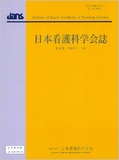Japanese
English
- 販売していません
- Abstract 文献概要
- 参考文献 Reference
要旨
目的:本研究は,grade I〜IIのSAHと診断された人の発症後1年間の経時的な体験について明らかにすることを目的とした.
方法:研究デザインは,Van Manen(1990/2011)の現象学的研究方法に基づく質的記述的研究である.非構成的インタビューは,研究参加者の入院中および退院約1か月後,3か月後,6か月後,1年後の外来受診などの通院日に合わせて一人につき計5回実施した.
結果:grade I〜IIのSAHの人は,予期しない出来事に振り回され,いつ何時どうなるかわからない状況に苦悩していた.その中で,自分のからだを試しながら,からだを捉え直し,回復の実感をつかみ,考え方を変化させ「慎重に生きる」方法を確立していたが,そこには多くの困難を伴い努力を必要としていた.
結論:看護師は,このような体験をしている人たちが自分のからだを捉え直し,回復の実感をつかんでいけるよう支援をしていく必要性が示唆された.
Objectives: This research will focus on people diagnosed with SAH of grade I & II, and I will clarify, in a longitudinal way, their experiences upon returning to society during the year after onset.
Methods: The research design used the phenomenological study method of Van Manen (1990/2011). The interviews were conducted five times including during hospitalization, one month after discharge, three months, six months, and one year after discharge.
Results: People with grade I & II SAH were found to have difficulties and suffered a great deal. There are two reasons for this: “Being influenced by unexpected events” and “That they do not know where and when something will happen”. Each of them gradually tested their body and tried to re-examine the capability of the body. As a result, they gained a sense of recovery. Since the process involves many difficulties and suffering, the presence of a person who continuously supports them is necessary.
Discussion: In order to facilitate their recovery, it is suggested that nurses, whose job it is to support health and living, will play an important role.
Copyright © 2022, Japan Academy of Nursing Science. All rights reserved.


